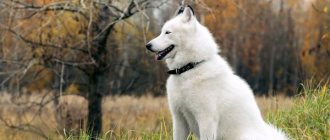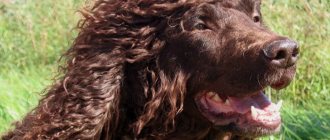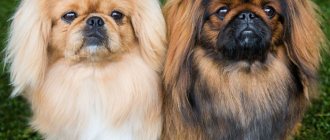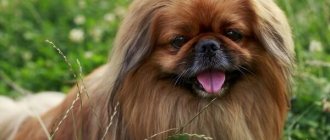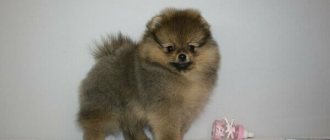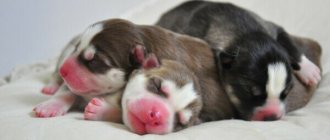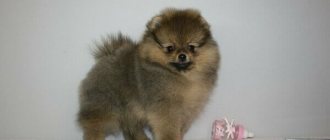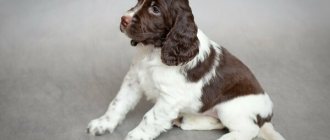The Alaskan Malamute has recently gained immense popularity among pet lovers. This breed was bred a long time ago, and for a long period man’s furry friends helped people achieve their goals in difficult weather conditions. Nowadays you can find an Alaskan Malamute proudly walking next to its owner in a city park. And there was a time when dogs of this breed helped people in the process of mining precious metals. Few could survive in such harsh conditions, but Alaskan Malamutes easily coped with all difficulties.
The Alaskan Malamute has recently gained immense popularity among pet lovers.
History of the breed
This breed has been known to man since ancient times. Back in the 17th century, Eskimo tribes used dogs with very thick fur and thick skin on the pads of their feet for transportation. This is still considered a distinctive feature of northern breeds. The tribes that bred the ancestors of the Alaskan Malamute constantly moved, so the animals had a lot of work. This required maximum endurance, which was passed on to modern representatives of the breed. At any time of the year, the dogs did their job perfectly. Here they had no equal.
It is worth noting that in harsh weather conditions, neither a person could survive without a dog, nor an animal could do without the care of its owner. The Eskimos highly valued their four-legged helpers, as they were not only distinguished by their high performance, but were also extremely devoted to humans.
This breed has been known to man since ancient times.
Dogs that served among the northern tribes were not mated with representatives of other breeds. Their endurance, beautiful appearance and other positive qualities came from nature initially, and were not bred artificially, like many other breeds. Quality and purebred were highly valued in those days, but the Gold Rush greatly harmed the northern dogs.
At this time, other hardy breeds began to be actively imported into countries such as Canada and Alaska. There was no time for quality here, since people were mainly interested in the number of hardy animals. With an acute lack of driving power, man learned to harness even wolf cubs.
The result was a strong mixture of species and breeds. Thus, most of the aboriginal dogs simply disappeared, and their place was taken by malamutes, which are similar in type to dogs such as the Spitz and the husky. However, in remote northern regions it was still possible to preserve the purity of the breed. Therefore, in our time, Malamutes have two lines, that is, two types of breed.
It is worth noting that in harsh weather conditions, neither a person could survive without a dog, nor an animal could do without the care of its owner
Alaskan Malamutes deserve great respect, since representatives of their breed withstood severe frosts and still remained fully functional. There are legends about northern dogs, books have been written about them and films have been made.
Health and diseases
Animals have strong immunity and no special health problems. You should pay attention to the health of your joints. The dog definitely needs physical activity and a balanced diet. Adults are recommended to take vitamins with glucosamine. Before reaching 12 months of age, 3 vaccinations are required. Mandatory vaccination is carried out once a year throughout life.
Common malamute diseases:
- Eczema (as a result of an unbalanced diet);
- Eye diseases: glaucoma, cataracts (genetics);
- Hip dysplasia.
Gallery: Alaskan Malamute (25 photos)
Upbringing
When raising a Malamute puppy, you need to take into account the wayward nature of this animal and its desire to become the boss in everything. The owner of such a pet will have to be persistent and patient: at first, dogs tend to follow only those commands that they like. You need to start training your puppy right away to instill in him an understanding of who is boss in the house. At the same time, it is strictly not recommended to put pressure on the animal, beat it or force it to do anything by force.
Why does it howl and how to wean it off?
First of all, in such a situation, you should make sure that the animal is healthy and not injured. Also, in many cases, dogs can warn their owners of danger. Even small pets are able to smell, for example, the smell of burning in the house before people do. If the dog is healthy and there is no danger, there are several reasons why Malamutes howl:
- The dog is bored and wants to walk or play. Howling often happens if the owners are in another room, busy or are not at home at all.
- Sensitivity to moon phases. Many dogs react to the full month and may feel anxious and suffer from insomnia.
- From happiness. Sometimes, with the help of a howl, malamutes notify a person that they are happy about his arrival or that they are going for a walk. Usually such a howl is short-lived.
- The dog is scared. Not all animals express fear by barking; sometimes pets can howl protractedly if, for example, an alarm suddenly went off or a loud bang was heard.
There are several ways to calm your dog:
- Increase physical activity: run, walk and play outdoor games more often. The dog will release excess energy and become calmer.
- Praise the animal for good deeds, communicate with it more often, pet it and pay attention. Do not leave your dog at home alone for a long time so that it does not become lonely.
- Use an anti-bark collar. This is a radical way. This device releases a small amount of current when the Malamute begins to bark. In many cases, the remedy is quite effective, but it is worth considering that this negatively affects the emotional state of the animal.
Why does he dig the ground?
Malamutes, starting from an early age, can actively dig the ground or, in the absence of such an opportunity, the floor. This habit is due to the fact that in the past, dogs of these breeds often found food for themselves underground .
They had to dig quite deep holes to get rodents out of them. Today, such a need has disappeared, but the pleasure from the excavation process remains at the genetic level.
In this regard, it is not recommended to get a Malamute if it is not possible to provide him with enough space for digging. You need to constantly walk the puppy where he can dig to his heart's content.
Ideal housing conditions are an enclosure with a dirt floor or a yard where the pet has freedom of movement.
How to properly train to stand?
You can start teaching the dog to stand up as early as 5–6 months. First, you should manually position the dog, keeping the front legs parallel and the hind legs back. Having achieved the desired position, you should hold the puppy for about a minute to consolidate the skill. After which you must reward the animal with a treat.
From the second training you can use a special collar. When equipped, it will be easier for the dog to keep its body in the correct position. Each time, the duration of the stance needs to be increased by 15–20 seconds, to eventually bring the time to several minutes.
Appearance
In order for dogs to be able to survive in the most difficult weather conditions, nature has endowed them with a considerable number of advantages that other breeds do not have. Although modern Alaskan Malamutes are somewhat different from their native ancestors, they are still impressive in appearance. These dogs are large, very strong and resilient. Each representative of the breed retains its original working qualities. Breeders who plan to keep such an animal at home should definitely remember this. A Malamute cannot live without work, so a person will have to travel a long way every day with his pet.
Energy level
Malamutes were bred to be working dogs and require daily exercise to keep them mentally and physically stimulated. Some traits are hard to break, such as the urge to dig, so it is helpful to find a positive outlet for this breed.
The Malamute is a great companion for those who love to explore, hike, swim, and spend time in the snow. These dogs will show their true personality when given the chance to run around in the snow, so be prepared for a playful and energetic dog when they encounter their native climate.
Malamute coat
Alaskan Malamute dogs are very beautiful. They have thick, coarse, medium-length fur. But in the neck area, on the upper part of the leg and tail, there may well be somewhat elongated hair. Dogs easily tolerate low temperatures due to their thick undercoat.
The Alaskan Malamute breed is not clipped. Only minor processing of the fur in the area between the toes is allowed.
As for color, dogs of this breed may have white, black and gray colors. A red-brown tint is allowed. There are usually two combinations of coat color. It is worth noting that Alaskan Malamutes can also develop albinos. But such colors are considered a defect in the breed. If there are marks on the white fur in the form of black or gray eyebrows, this is considered normal.
The nose and lips of dogs with black spots will be dark, while those of the breed with brown accents may be sandy in color.
How to choose?
To be sure of the purebred and health of the puppy, you should purchase it from a specialized nursery. Before purchasing, you need to familiarize yourself with the living conditions of the dogs and find out about the health, character and other characteristics of the parents of the future pet.
In a healthy puppy the breed standard :
- scissor bite;
- shiny coat without dandruff or bald patches;
- clean skin without rashes, signs of irritation, scratching, redness;
- moist nose and clean, clear eyes;
- There is no increased lacrimation, discharge from the nose or ears.
NOTE!
A small Malamute should be developed in accordance with its age, be active, curious and sociable.
Showing cowardice or aggression is considered a fault.
Dog character
With proper training, there will be no problems with the Alaskan Malamute. For the most part, these are good-natured dogs that are easy to train. The characteristics of this breed are boundless curiosity and love of humanity. A malamute will never leave its owner in trouble.
As for living together with other breeds, it is quite acceptable. But you need to take into account that the Malamute is by nature a leader and leader, so the dog will force all surrounding animals to live by its rules. If they agree, there shouldn't be any problems. It can be difficult with cats who are not particularly eager to live by someone else’s rules. But with the right approach on the part of the breeder, cohabitation is quite possible.
A person who has decided to get himself an Alaskan Malamute puppy must take into account that this dog will not be considered to have a strong enough character. If the breeder constantly shows his weakness, he will not be able to raise the Malamute correctly. In turn, this can be very dangerous. Dogs of this breed are very large and powerful, so if the animal is uncontrollable, this can lead to serious problems.
The Alaskan Malamute is endlessly loyal to its owner. But he will consider as such only a person with a strong character, that is, a leader who can prove that he is smarter, more cunning and stronger than his dog. Training a dog of this breed will take some work. Beginners will not be able to train a Malamute; this requires the hand of a professional. It is especially difficult to teach a dog simple commands, since representatives of this breed really do not like monotonous work. They perform standard tasks only out of great love for their master.
The Alaskan Malamute is a dog with enormous working and physical potential. This breed is not intended to be kept in an apartment, as it needs frequent exercise, which is impossible to obtain in an urban environment. An exception may be bikejoring, that is, using the strength of a dog to move a bicycle. Malamutes in harness must run about 10 km a day. In this case, the animal will be happy and healthy.
Ideal home environment
The Malamute is great for anyone who leads an active lifestyle and is ready for consistent and diligent training. Although he loves people, he can be irritable around other dogs, cats or livestock. Early socialization is key to avoiding problems in adulthood.
Malamutes are known for being excellent family dogs and good with children, but like all dogs, it is important to socialize with children early. It is also important to teach children how to properly interact with their pet.
The ideal Malamute owner will be prepared for his stubbornness and keen intelligence. It is important to remember that a Malamute needs an owner that he respects, otherwise he will run the house and that will never be good for everyone.
An ideal home will have a place where the malamute can roam freely and the yard will be securely fenced to prevent the malamute from escaping. As long as you and your family are prepared for an active dog with high energy, the Malamute will be a pleasant and affectionate addition to your family.
Content Features
Recently, Alaskan Malamutes can often be found on city streets, in parks and courtyards of residential buildings. The breed has become very fashionable and popular. One of the famous nurseries of this breed is located in the Altai Territory. However, many people do not think about how difficult it is for such a dog to live in an apartment. If the owner leaves early in the morning for work and returns late in the evening to take the dog outside for 10 minutes, such a life is absolutely not suitable for an Alaskan Malamute.
These dogs need space. A private house with a large local area would be the best option. In this case, it is imperative to fence the area with a high and deep fence. The latter is important because Malamutes constantly dig holes and trenches. This is their second favorite activity after running and carrying heavy objects. A fence is needed not only to prevent a curious dog from running away, but also to protect against uninvited guests. The Alaskan mammut does not differ in its protective qualities.
Which dry food to choose?
Foods such as Pedigree, Chappi, Darling, ARO, which are budget economy class products, are not suitable for feeding Malamute puppies.
They do not contain essential vitamins and minerals, and instead of meat they contain low-quality meat waste, soy, flavorings, preservatives and flavor enhancers..
Malamutes can be fed only with high-quality food of at least premium class. It is best to purchase hypoallergenic food for large breed puppies. Products from the brands Acana, Orijen, Husse, and Forza are popular.
Useful video
The video explains how to care for and raise Malamute puppies:
Source
| Newborn | 0,35-0,65 | — |
| 1 | 2-3 | 28-30 |
| 2 | 8-12 | 32-35 |
| 3 | 15-18 | 38-45 |
| 4 | 18-20 | 40-50 |
| 5 | 20-27 | 45-55 |
| 6 | 22-28 | 48-55 |
| 7-8 | 26-30 | 50-55 |
| 9-11 | 28-35 | 55-60 |
| 12-18 | 30-40 | 55-65 |
Weight table by month
To track how harmoniously a small Malamute is developing, the easiest way is to compare its individual indicators with the general average. To help the owner there is a weight table.
Age (months):
Height at withers (cm):
While it is not difficult to measure a puppy’s weight, growth is somewhat more difficult. You can take the correct measurements according to the instructions:
- Place the dog in a show rack. In order for the Malamute to stand still, his attention is attracted with a treat or a toy.
- It is best to take measurements together with an assistant - one person carries out the procedure, the other attracts the dog’s attention.
- It is important that the dog is on a flat and hard surface - for example, on the floor or asphalt.
- First, part the dog’s long and thick hair so that the withers are more clearly visible.
- The simplest measuring tool is a measuring tape. You can use a special ruler with limiters.
- When measuring using a tape, the zero edge of the divisions is applied to the dog's withers. Pull the tool to the floor (perpendicular to the ground), make a mark on the tape where it comes into contact with the surface.
- The measuring ruler is placed with the zero mark on the floor, and the limiter is raised to the dog’s withers.
As for adult animals, the following average parameters are introduced for them:
Nutrition
How carefully you monitor your pet's diet will determine how successful your training and performances in competitions will be. And feeding a puppy is a double responsibility.
Complementary feeding per month
The best food for a puppy up to 1 month is mother's milk. Puppies of this age are fed 6 times a day with breaks of 3 hours. From an older age, you can introduce complementary foods, or eliminate milk altogether, because... The puppy can already be picked up by new owners.
What to feed at 2 months?
From 2 to 3 months, a Malamute puppy needs to be fed 3-4 times a day, then two meals will be enough. The puppy's diet should consist of:
Further diet
Care must be taken to ensure that the dog receives enough vitamins and microelements. The diet can consist of both natural products and specialized feed. But don't forget to monitor its quality. From natural food it is preferable:
- beef;
- chicken;
- turkey;
- sea fish;
- offal;
- cereals and vegetables.
This breed of dog has an excellent appetite, so you need to make sure that your pet does not overeat. After eating, it is better to clean the bowl and fill it with clean drinking water.

